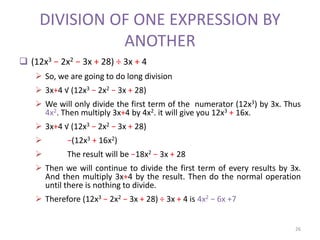The document discusses algebra and its basic concepts. It begins by introducing algebra and defining it as the aspect of mathematics involving the use of numbers and letters. It then provides examples of solving algebraic puzzles using letters to represent unknown numbers. The document goes on to define key algebraic terms like constants, variables, coefficients and terms. It also outlines fundamental algebraic rules like commutativity, associativity and distributivity. It discusses how to collect like terms and factorize expressions. Finally, it covers topics like expanding and simplifying brackets, fractions and factorizing expressions.

















![Expanding Brackets
What if you have a negative sign?
− 2y (2x − 4z)
First multiply through by 2y
− [ (2y × 2x) − (2y × 4z)]
− [4xy − 8yz]
Multiply through by the negative sign
−4xy + 8yz
18](https://image.slidesharecdn.com/algebra1-6-180321053857/85/Algebra-18-320.jpg)
![NESTED BRACKETS
When ever an algebraic expression contains brackets that
are nested within each other, you will start simplifying from
the innermost bracket.
4 {2a + 3 [5 −2 (a−b)]}
Start simplifying from innermost bracket
4 {2a + 3[5 − 2a − 2b]}
Next bracket
4{2a + 15 − 6a − 6b}
Next bracket
8a + 60 − 24a − 24b
19](https://image.slidesharecdn.com/algebra1-6-180321053857/85/Algebra-19-320.jpg)










![Addition and Subtraction of Algebraic
Fractions
Simplify 2/(x+1) + 4/(x+2)
First, look for the LCM which is (x+1) (x+2)
Divide the LCM by the denominator (x+1). The answer is (x+2). Then (x+2)
multiplied by 2 is 2(x+2).
For the second one divide the LCM by the denominator. The answer is (x+1).
Then (x+1) multiplied by 4 is 4(x+1).
Add your two results together and divide by the denominator
[2(x+2) + 4(x+1)] / (x+1) (x+2)
Expand the brackets of the numerator and denominator
(2x + 4 + 4x +4) / ( x2 +3x +2)
Collect like terms at the numerator
(2x + 4x + 4 + 4) / ( x2 +3x +2)
(6x + 8 )/ (x2 +3x +2)
30](https://image.slidesharecdn.com/algebra1-6-180321053857/85/Algebra-30-320.jpg)






























